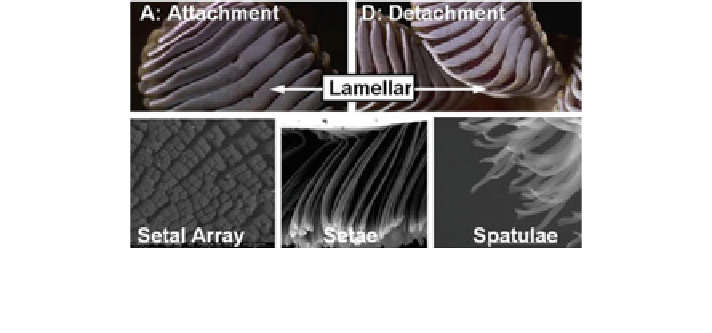Environmental Engineering Reference
In-Depth Information
Fig. 9.11 Hierarchical structure of a gecko and its initial contact to a surface: lamellae
(attachment and detachment), and setal arrays to the spatulae are highlighted (Adapted with
permission from Tian et al.
2013
)
adhesion is again the presence of hierarchical structures: each toe is covered with
rows of overlapping pads (lamellae) each consisting of millions of densely packed
microscale hair, called setae, further branching off in nanoscale spatulae
(Fig.
9.11
). This creates a huge contact area—ultimately, gecko adhesion is pri-
marily pushed by van der Waals forces (Ruibal and Ernst
1965
).
Still, a crucial aspect that was not considered in early studies on gecko spatulae
is their ability of remaining clean from contaminants (Hansen and Autumn
2005
):
this has recently become the focus of a new branch of biomimetic self-cleaning
surfaces.
The mechanism diverges from those previously described, which all involve the
action of water. In this case, a disequilibrium in adhesive forces between dirt,
substrate and gecko spatulae has been indicated as the source of such phenomenon.
In spite of the huge adhesive strength of full setae, dirt particles—due to their small
size—can only adhere to few spatulae: as a consequence, the substrate-particle
adhesion strength remains higher than the setae-particle one, and can even help
restoring clean spatulae in case of contamination by simply moving the setae on
the surface, which generally occurs within few steps (Hansen and Autumn
2005
).
In fact, gecko feet do accumulate dirt, but the essence of their self-cleaning is the
ability to clean toe pads while in motion.
Self-cleaning of gecko—and other insects, such as Hymenopterans, Coccinel-
lids and Phasmatodeas—was further studied thoroughly by several research
groups (Clemente et al.
2009
; Hu et al.
2012
; Orchard et al.
2012
), in order to get a
deeper insight of the process and replicate it, by monitoring the variations of
adhesive strength of their feet—which lose stickiness when contaminated, and
recover it when clean. Hu et al. proposed in 2012 a dynamic digital hyperextension
mechanism: setae can recover up to 80 % of their adhesive strength in only four
steps in hyperextension mode, that is, with sudden releases, while the recovery
limits to 40-50 % in case of absence of digital hyperextension motion.

Search WWH ::

Custom Search